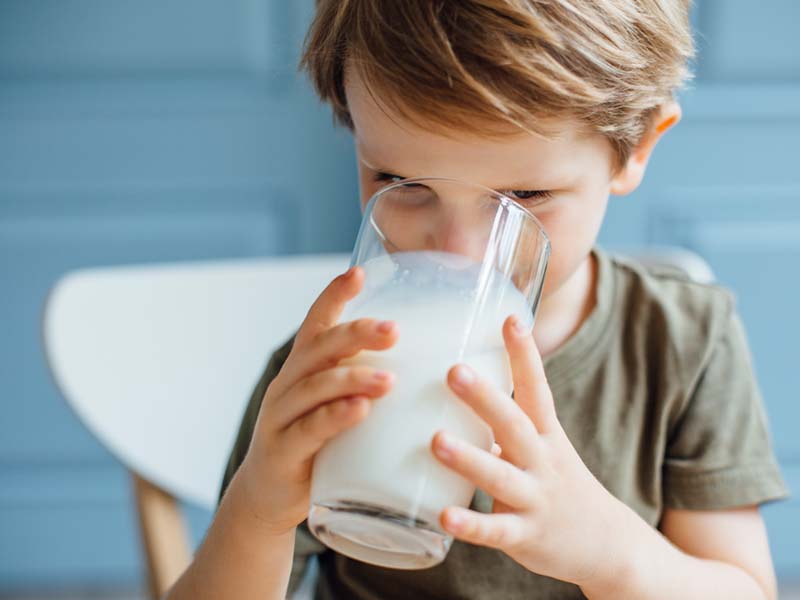
There’s an old Calvin and Hobbes cartoon in which Calvin points out how unusual it is that humans drink milk that comes from cows.
“Who was the guy who first looked at a cow and said, ‘I think I’ll drink whatever comes out of
these things when I squeeze ’em’?” Calvin says.
Perhaps drinking milk does seem unusual, if you think about it that way! But humans have been consuming milk for
millennia — and not just milk from cows, but from sheep, goats, and other animals, too.
When did humans start consuming milk from other animals, and why?
According to research published in the Archaeological and Anthropological
Journal in September 2019, people may have been consuming milk for about 6,000 years1.
Scientists analysed plaque from the teeth of the skeletons of Neolithic farmers from Britain, revealing traces of a
protein (called beta-lactoglobulin) that is present in cow, sheep and goat milk.
Even if it doesn’t quite answer Calvin’s question about who the first person to drink milk was, we do
have a theory as to why he did it: milk was an excellent nutritional source.
Although he may have suffered a bit — as Neolithic people (those living between 4000 BC and 2400 BC) did not yet have the genetic mutation that
allows people to consume milk into adulthood2.
How did the decision to drink milk affect human evolution?
Without getting too technical, there’s an enzyme called lactase which helps us digest the milk sugar, lactose.
This enzyme is something we need as babies but need a lot less of as we get older and no longer drink our
mother’s milk.
But some people have a genetic mutation, called lactase persistence, which allows them to digest milk into adulthood.
Some scientists think that until about 1000 BC comparatively few people had this genetic mutation. But as early
farming practices began to spread, mainly through Europe, there is some research to suggest that lactase persistence
became more common. Today in northern Europe it is estimated that around 90 per cent of people are lactase
persistent3.
What is lactose intolerance?
Lactase persistence is not a universal trait and many people around the world are actually lactose intolerant, and
it’s not clear yet why some people are and some people aren’t.
Being lactose intolerant means their body is unable to digest lactose and, if they consume it, they will experience
symptoms — usually within a few hours. Common symptoms include a bloated stomach, cramps, pain, a rumbling
stomach, wind, diarrhoea, and a general feeling of sickness.
What are the benefits to humans of drinking milk?
Milk and milk products, like cheese and yoghurt, are a great source of many vital nutrients, including:
- Calcium
- Protein
- Iodine
- Vitamin A
- Vitamin B12
- Vitamin D
- Riboflavin
- Zinc.
Milk is also a source of fat and saturated fats, which can have adverse health effects if consumed in too great a
quantity, so it’s better to choose reduced-fat options.
Australian nutritional guidelines recommend adults consume at least two and a
half serves of mostly reduced-fat milk, cheese, yoghurt or their alternatives per day4. The recommendations for young
children and adolescents vary.
Consuming the recommended amounts of reduced-fat dairy has been linked to multiple health benefits, including reduced risk of
cardiovascular disease, type 2 diabetes, excess weight and some cancers4.
What are the alternatives to dairy?
Whether you are lactose intolerant or want to reduce or eliminate your intake of dairy products for a different
reason, there are now more alternatives available than ever. Options now common on many supermarket shelves include
soy, almond, oat and rice “milk”.
If you’re choosing a milk alternative, check the information on the packaging for the following:
- Calcium content: make sure you are choosing “milk” that is calcium fortified (choose a brand with at
least 120mg of calcium per 100mL)
- Added sugar: look for unsweetened versions
- Protein: most plant-based milks are not as protein-rich as animal milk (soy is the closest, and quite unique for
plant-based milks).
If dairy alternatives aren’t appealing, you can get all the nutrients you need from other food sources. If you
are unsure of how to do this, seek advice from a dietitian or your GP. For example, you can get calcium from canned
sardines or salmon, tofu, and vegetables like beans and broccoli.
What should the role of dairy be in your overall diet?
If you’re going to consume milk or its modern alternatives, it’s important to always consider them in the
context of your nutritional needs and your overall dietary intake.
Milk should always be just one part of a healthy, balanced diet.
Sources:
1 Springer Link - New insights into Neolithic milk consumption through proteomic analysis of dental calculus (2019)
2 BBC - Earliest direct evidence of milk consumption (2019)
3 The Royal Society - Evolution of lactase persistence: an example of human niche construction (2011)
4 Eat For Health - Australian Dietary Guidelines (2013)